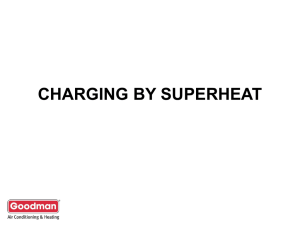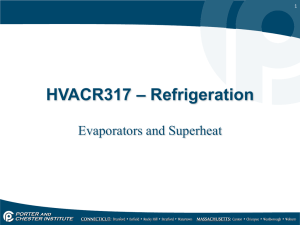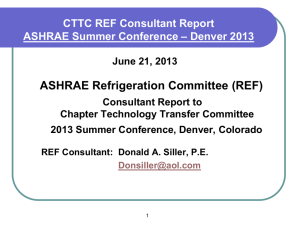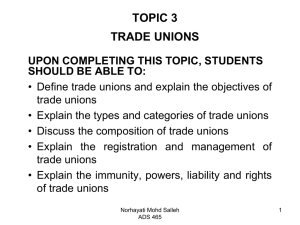Interpreting System Symptoms
advertisement
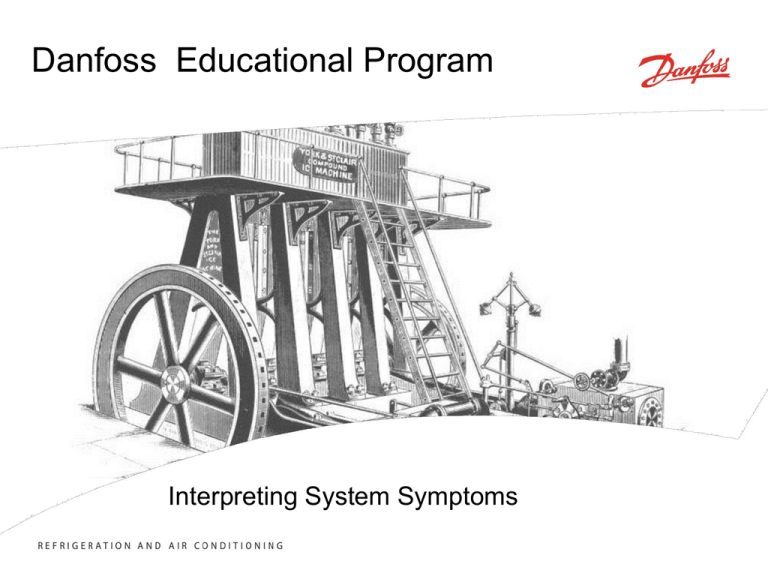
Danfoss Educational Program Interpreting System Symptoms Competitors Comparison REFRIGERATION AND AIR CONDITIONING DS, TSO Nov-08 / 1 Index • Welcome & Intro to Danfoss • Laying the foundation: • Basic System Operation and components • SH and SC • Equilibrium and system balance • Load effects on: • Superheat • Subcooling • Impacts of valve capacity • Ambient Effects on: • Superheat • Subcooling • Dealing with Low Ambient Conditions • Pressure Controls and Regulators • Causes of Abnormal Superheat REFRIGERATION AND AIR CONDITIONING Nov-08 / 2 Danfoss – Yesterday and Today • Founded by Mads Clausen in 1933 – First product was a TXV – Rapidly expanded into other products and markets • Today, still owned by founder’s family • Net sales in 2012, $6.0 Billion US • 26,000 employees worldwide • 93 Manufacturing plants • 139 Sales Companies • Largest controls manufacturer in the world – One of the largest manufacturers of compressors • What we Hope to Accomplish • The relationship balance between key components such as expansion valves, compressors and heat exchangers • How to relate ambient and load conditions to the measurements you are seeing to fully understand what subcooling and superheat values are indicating • Don’t touch that superheat dial! (How to quickly troubleshoot common TXV feeding problems.) • Recognizing and understanding the key information to solve the real issues and reduce call backs Calculating Super Heat Superheat = leaving temp – saturation temp = 28F° - 20F° = 8F° For R-134a , Saturation Temperature @ 18 psig = 20F° (From a P-T chart) Danfoss Refrigeration 18 psig 28F° Refrig TXV TUA/TUAE |5 Calculating Subcooling Example for R-410A Subcooling = Saturation Temp – Liquid Temp = 110F – 98F = 12F° The liquid is sub cooled 12 degrees. Liquid temp @ outlet = 98F Danfoss Refrigeration Condenser pressure = 365 psig = 110F° from P-T Chart Refrig TXV TUA/TUAE |6 Equilibrium In this basic system, there is really only one path for the refrigerant to flow through In this respect, it follows the same rules as a series circuit in electricity What flows in one area also must flow in the rest of the system Danfoss Refrigeration Refrig TXV TUA/TUAE |7 Equilibrium • The main concept here is that the flow through the TXV must be balanced by the pumping capacity of the compressor • This state can be referred to as ‘equilibrium’ • In equilibrium, the pressures and temperatures do not change • We see this when the load and ambient conditions are constant Danfoss Refrigeration Refrig TXV TUA/TUAE |8 Load Changes and System Pressures • If one of the parameters changes, say the air flowing over the evaporator becomes warmer, the equilibrium will be broken and the system conditions will begin to change • In this case, if a TXV is used, the valve will begin to open and inject more refrigerant into the evaporator Danfoss Refrigeration Refrig TXV TUA/TUAE |9 Load Changes and System Pressures • This extra refrigerant flowing into the evaporator has to go somewhere and in this case it must be pumped thru the compressor • However, in order for the compressor to move more mass of refrigerant, the density of the refrigerant must increase • As a result, the pressure and temperatures in the evaporator will increase Danfoss Refrigeration Refrig TXV TUA/TUAE | 10 Load Changes and System Pressures • For a certain volume, the higher the density of the vapor, the more mass it will contain This cylinder contains 50% more refrigerant 1 ft3 1 ft3 R404A @ 20 psig 1 ft3 = 0.79 lbs. Danfoss Refrigeration R404A @ 40 psig 1 ft3 = 1.21 lbs. Refrig TXV TUA/TUAE | 11 Load Changes and System Pressures • As a result of this phenomena, if a system is coming out of defrost, what would we expect the evaporator pressure to be? • Higher than normal? • Lower than normal? Danfoss Refrigeration Refrig TXV TUA/TUAE | 12 Superheat and Load - TXV • One of the symptoms that will be observed during periods of high load will be an increase in evaporator superheat • This is because of the increase in bulb pressure required to compress the superheat spring to further drive the valve open. Danfoss Refrigeration Refrig TXV TUA/TUAE | 13 Superheat and Load - TXV Static Superheat (SS) Valve Capacity Full Open Capacity Reserve Capacity Superheat necessary to overcome spring force Rated Capactiy Opening Superheat (OS) Superheat required to move valve pin from seat SS OS Superheat OPS Danfoss Refrigeration Operating Superheat (OPS) Superheat at which the valve operates (SS + OS) Refrig TXV TUA/TUAE | 14 Superheat and Load – TXV Sizing Valve Capacity Full Open Capacity Reserve Capacity Rated Capactiy SS OS The impact of valve size on superheat will be greatest during periods of heavy load. Superheat OPS Danfoss Refrigeration Refrig TXV TUA/TUAE | 15 Superheat and Load - TXV Proper sized TXV Valve Capacity Undersized TXV Pull-down Load Nominal Load Excessive superheat Superheat Danfoss Refrigeration Refrig TXV TUA/TUAE | 16 Load Effects on SC (TXV Equipped) • By it’s nature, subcooling requires a temperature difference between the refrigerant and the ambient surroundings • The greater the temperature difference, the greater the amount of subcooling that is possible • This is true regardless of what is causing the temperature difference Danfoss Refrigeration Refrig TXV TUA/TUAE | 17 Load Effects on SC TXV Equipped • When system load is high, the TXV’s will inject more refrigerant into the evaporators resulting in greater compressor hp to pump the vapor • Because of this, the condenser will have a higher Total Heat of Rejection (THR) requiring a greater TD between the air and the refrigerant resulting in a greater level of sub-cooling in the liquid High load Condensing temp = 110F°, Liquid = 96F° Danfoss Refrigeration Low load Condensing temp = 104F°, Liquid = 93F° Refrig TXV TUA/TUAE | 18 Condenser Size- TXV Equipped • A smaller condenser for a given capacity will generate more subcooling than a larger condenser • Similarly, higher ambient conditions will do the same 9F° SC 12F° SC Danfoss Refrigeration Refrig TXV TUA/TUAE | 19 Condenser Size- TXV Equipped • This effect is the result of the condensing temperature needing to be higher to maintain the TD between the ambient air and the refrigerant temperatures • This results in a higher compression ratio, greater compressor work and more THR for a given load 12F° SC 9F° SC Ambient is 97F° Condensing temp = 120F°, Liquid = 108F° Ambient is 76F° Condensing temp = 95F°, Liquid = 86F° Danfoss Refrigeration Refrig TXV TUA/TUAE | 20 Ambient Effects on SC - TXV Equipped A condenser that is recycling discharge air will have an abnormally high condensing pressure and a high subcooling level 92F° Ambient 112F° 112F° 102F° Danfoss Refrigeration 92F° Ambient 102F° Refrig TXV TUA/TUAE | 21 Amb. Effects on SC – Piston & Cap Tube • Below is a graph plotting subcooling vs. outdoor temperatures • Notice how the subcooling can drop to low levels on very hot days due to large amounts of refrigerant situated in the evaporator “starving” the condenser Subcooling 14F° This is a result of flow rate into evaporator increasing as condensing pressure increases. 10F° 6F° 2F° 70F° Danfoss Refrigeration 80F° 90F° Refrig TXV TUA/TUAE 100F° Ambient T (F°) | 22 Subcooling • A cooler with a TXV has just been loaded with warm product. Superheat and subcooling will be: • Higher than normal? • Lower than normal? Danfoss Refrigeration Refrig TXV TUA/TUAE | 23 Subcooling • On a coldish day, you notice that on a 6 fan condenser, the condensing fans are all running despite 2 out of 3 compressors being idle due to low evaporator loads. • What would you expect the level of subcooling leaving the condenser to be if TXVs is used? • Higher than normal? • Lower than normal? Danfoss Refrigeration Refrig TXV TUA/TUAE | 24 Ambient Effects on Superheat • Capillary tube flow rates depend on length, diameter and pressure differential • All else being the same, the greater the pressure difference across them, the more flow 110 psi differential 210 psi differential Danfoss Refrigeration Refrig TXV TUA/TUAE | 25 Ambient Effects on Superheat • Pressure differential is the difference between condensing and evaporator pressures • An increase in condensing pressure will result in greater refrigerant feed into the evaporator • On high ambient days, the condensing pressure will increase in outdoor condensers Cool Day Hot day Danfoss Refrigeration Refrig TXV TUA/TUAE | 26 Amb. Effects on SH – Piston & Cap Tube Danfoss Refrigeration Refrig TXV TUA/TUAE | 27 Amb. Effects on SH – Piston & Cap Tube Danfoss Refrigeration Refrig TXV TUA/TUAE | 28 Ambient Effects on Superheat • Below is a graph plotting superheat vs. outdoor temperatures • Notice how the superheat can drop to low levels on very hot days • If the cap tube is slightly oversized for the condenser, liquid flood back to the compressor may occur SH (F°) 14F° This is a result of cap tube flow rate increasing more than the load on the evaporator 10F° 6F° 2F° 70F° Danfoss Refrigeration 80F° 90F° Refrig TXV TUA/TUAE 100F° Ambient T (F°) | 29 Ambient Effects on Superheat (TXVs) For TXV’s it is the opposite concern of too little pressure difference across the valve This can occur during low ambient conditions in refrigeration systems that are located where the temperature can vary widely such as in the northern US and Canada Danfoss Refrigeration Refrig TXV TUA/TUAE | 30 Ambient Effects on Superheat • This problem is especially acute during system start or during periods of low load and in units with no fan control • The issue stems from a lack of pressure difference across the valve because of abnormally low condensing pressures • This results in the valves sticking or failing to feed properly Danfoss Refrigeration Refrig TXV TUA/TUAE | 31 Ambient Effects on Superheat • Capacity can be reduced by as much as 50% • High superheat levels , long run times, and the inability to maintain temperature set points Valve Capacity Nominal Pressure Differential Insufficient Pressure Differential Superheat Danfoss Refrigeration Refrig TXV TUA/TUAE | 32 Scenario Investigation • A cooler with a 1 hp out door condenser is equipped with a TXV It cannot meet the pull down times required and superheat is 22F° at evaporator outlet. The outdoor ambient is 38F° • What would you expect the pressure and temperature readings to be? Hint: The cardboard test is great for this scenario! Danfoss Refrigeration Refrig TXV TUA/TUAE | 33 Methods of Condenser Pressure Control • The most common method of controlling pressure in the condenser is through the use of fan staging. • This incorporates either 2 or more fans, a variable speed fan or combination of both • The volume of air flow through the condenser is increased or decreases in response to a rise or fall in condensing pressure and ambient conditions Danfoss Refrigeration Refrig TXV TUA/TUAE | 34 Condenser Pressure Control Temperature = 90F When the outdoor temperature is lower, the condenser acts like it is a lot larger Temperature = 50F Danfoss Refrigeration Refrig TXV TUA/TUAE | 35 Condenser Pressure Control Condensing Temperature = 110 Fahrenheit 90 degree Fahrenheit Air Inlet Temperature •Condensers are designed for a certain difference between the outside ambient temperature and the condensing temperature •Fan cycling allows the use of large condensers that can reject heat with the smallest difference between the ambient and condensing temperatures feasible while allowing for lower load and ambient conditions Danfoss Refrigeration Refrig TXV TUA/TUAE | 36 Condenser Pressure Control Condensing Temperature = 90 Fahrenheit Less airflow needed when air inlet is only 50 degree °F •Because the condenser must be able to reject heat even at high loads, the condenser must be large enough to reject this heat even when it is hot outside i.e. 90F •However, during periods of low load and or low ambient conditions, less airflow is required to remove heat while still maintaining sufficient high side pressure Danfoss Refrigeration Refrig TXV TUA/TUAE | 37 Condenser Pressure Control Condensing Temperature = 90 Fahrenheit Less airflow needed when air inlet is only 50 degree °F •To accomplish this balance, having multiple fans that can be turned off and on allows substantial flexibility in controlling airflow •It is not uncommon for all fans to be off during cool weather when the system is first started and it may take several minutes to build pressure before the first stage is started Danfoss Refrigeration Refrig TXV TUA/TUAE | 38 Condenser Pressure Control Setting of Controls Setting of pressure controls requires the adjusting of the set point and the differential value if it is not fixed. Example: Cut out = Cut in – Diff. = 50psig – 20 psig = 30 psig Cut out = 30 psig Danfoss Refrigeration Refrig TXV TUA/TUAE | 39 Condenser Pressure Control Fan Control Operation P I. When the pressure exceeds the upper set point, contacts 1 and 4 make and bring on fan/s II. I. USP II. When the pressure falls to the lower set point, the contacts change back to the initial position and turn fan/s off. LSP USP = Upper Set Point LSP = Lower Set Point Danfoss Refrigeration Refrig TXV TUA/TUAE Differential | 40 Condenser Pressure Control Minimum required condensing temperature = 80°F When the ambient is 30°F or lower, it can be very difficult to maintain a minimum level of condensing temperature even if all fans are off. This is especially acute in regions with large seasonal temperature swings Danfoss Refrigeration Refrig TXV TUA/TUAE | 41 Condenser Pressure Control Pressure regulators • Pressure regulators are used to maintain pressures within an acceptable or desired level • They are used in applications where it is possible for operating pressures to develop that are outside of the operating limits for components or for the “product” that is being maintained • Pressure regulators are also used for capacity control to make up for a shortfall in evaporator load compared to compressor pumping capacity ( Air driers) Danfoss Refrigeration Refrig TXV TUA/TUAE | 42 Condenser Pressure Regulators Condenser Used in the liquid line before the receiver Danfoss Refrigeration Refrig TXV TUA/TUAE | 43 Condenser Pressure Regulator •When the condenser effectively becomes larger, the condensing pressure can drop substantially ,causing the TEV to operate erratically •The CPR acts by reducing the area available for heat rejection, effectively making the condenser smaller Danfoss Refrigeration Refrig TXV TUA/TUAE | 44 Condenser Pressure Regulator This the way the condenser behaves when liquid is backed up in it Only a portion of it can reject heat •The CPR accomplishes this by backing up the liquid in the condenser, using up free volume •The condenser then has a smaller area available to reject heat from the refrigerant Danfoss Refrigeration Refrig TXV TUA/TUAE | 45 Heat Energy - Enthalpy Temperature Enthalpy is the heat in BTUs per pound added to or removed from a substance, in this case water. 212 °F heating water (liquid) superheating vapor boiling water (liquid + vapor) 970 BTU/lb 180 BTU/lb Danfoss Refrigeration Heat (Energy) Enthalpy Refrig TXV TUA/TUAE | 46 Receiver Capacity!! • In the summer months, the condenser will hold substantially less refrigerant and this refrigerant will need to be stored in the receiver • It is important to ensure that there is enough receiver capacity to hold the extra refrigerant charge that is necessary to properly accomplish this Danfoss Refrigeration Refrig TXV TUA/TUAE | 47 Basic Troubleshooting Causes of Abnormal Superheat • There are several scenarios that can cause an undesirable level of superheat at the evaporator outlet • The causes can differ depending on the metering device utilized • This section will focus on both simple restriction and TXV type metering devices Danfoss Refrigeration Refrig TXV TUA/TUAE | 48 Causes of Abnormal Superheat Metering Device Sizing • We have already seen how the ambient conditions can effect the feeding of simple restrictions resulting in abnormally high or low SH readings • Similar symptoms will also be observed for metering devices that are not sized correctly • Cap tube flow rate is determined by their length and diameter Longer length/smaller diameter Shorter length/larger diameter Danfoss Refrigeration Refrig TXV TUA/TUAE | 49 Causes of Abnormal Superheat Metering Device Sizing • Piston fed systems are also affected by orifice size and one that is larger or smaller than specified will not feed properly • Always check the size and/or length of simple restriction fed systems against the manufacturers specifications and always make sure you correctly measure the ambient conditions as you will need this information Danfoss Refrigeration Refrig TXV TUA/TUAE The piston in this distributor should be sized correctly | 50 Causes of Abnormal Superheat Metering Device Sizing • TXV’s will have either a fixed or interchangeable orifice that determines the capacity range of the valve • An undersized orifice will result in excessively high superheat levels , longer pull down times and the inability to meet temperature set points • An oversized orifice may amplify any problems that normally would not be severe enough to adversely affect the system Danfoss Refrigeration Refrig TXV TUA/TUAE | 51 Causes of Abnormal Superheat Sensing Bulb Heat Transfer Proper Bulb Strap Placement • 60% of the heat transferred to the sensing bulb comes via the bulb mounting strap • It must always make good physical contact with the bulb and the refrigerant tubing • Do not use zip ties or other non conductive materials! Danfoss Refrigeration Refrig TXV TUA/TUAE | 52 Causes of Abnormal Superheat Sensing Bulb Heat Transfer Guidelines: • Securely mount the bulb on the evaporator outlet downstream from the refrigerant header if present Header • Mount the bulb in a position on the pipe least affected by liquid refrigerant and oil TXV Bulb Suction Line Danfoss Refrigeration Refrig TXV TUA/TUAE | 53 Causes of Abnormal Superheat Sensing Bulb Heat Transfer Guidelines: • Bulb should always be completely insulated with a foam type insulation • Exposure to the air may cause the valve to overfeed, resulting in low superheat and possible flooding of the compressor Danfoss Refrigeration Refrig TXV TUA/TUAE | 54 Causes of Abnormal Superheat Metering Device Blockages Of those with faults, 90% of returned valves are inoperable because of outside influence, primarily contamination or overheating Generally debris will cause the valve to underfeed but it can also cause the valve to stick, resulting in superheat levels that are too high or low for the corresponding load. Danfoss Refrigeration Refrig TXV TUA/TUAE | 55 Causes of Abnormal Superheat Metering Device Blockages Screen traps dirt in system • If the filter screen in the TXV becomes excessively plugged, it can cause liquid flashing as well as reduced flow into the TEV • If possible, when you suspect the screen is plugged, remove orifice to inspect and clean • If system is already open, take the time to check! Danfoss Refrigeration Refrig TXV TUA/TUAE | 56 Causes of Abnormal Superheat Line component Restrictions R404A @ 235psi 60psi pressure drop due to plugged drier 8F° of subcooling Formation of flash gas and liquid temperature drops to ~ 80F ° Low evap. pressure, starved evaporator etc. An obstruction in the liquid line can produce flash gas and can be detected by a pressure drop as well as by a detectable temperature difference. Danfoss Refrigeration Refrig TXV TUA/TUAE | 57 Causes of Abnormal Superheat Internal Equalization with High PD Evaporators An evaporator with a high equivalent pressure drop requires the use of an externally equalized TXV Internally Equalized TXV Evaporator pressure Externally Equalized TXV Evaporator pressure acting on diaphragm is from outlet, not inlet acting on diaphragm is from inlet To Evaporator Outlet Equalizer pressure reaches diaphragm from valve outlet – along pushpin or a bored hole Danfoss Refrigeration External Equalizer Inlet Refrig TXV TUA/TUAE | 58 Causes of Abnormal Superheat Internal Equalization with High PD Evaporators A distributor introduces a large pressure drop right after the TEV This results in a higher pressure being applied under the diaphragm Danfoss Refrigeration Refrig TXV TUA/TUAE | 59 Causes of Abnormal Superheat Internal Equalization with High PD Evaporators • Example #1 System Conditions – – – – Refrigerant is R404A Evaporator pressure is 57 psig. TXV is set for 9°F static superheat Pressure drop across distributor and evaporator is 11psi • Example #2 System Conditions – – – – Refrigerant is R404A Evaporator pressure is 25 psig. TXV is set for 9°F static superheat Pressure drop across distributor and evaporator is 11psi Danfoss Refrigeration Refrig TXV TUA/TUAE | 60 Causes of Abnormal Superheat Internal Equalization with High PD Evaporators External equalization allows for the actual evaporator pressure to be supplied under the diaphragm so the valve does not under feed the evaporator resulting in excessive superheat Danfoss Refrigeration Refrig TXV TUA/TUAE | 61 Causes of Abnormal Superheat Incorrect Superheat Adjustment Turning CW = + SH Turning CCW = - SH • Very rarely will a TXV superheat setting need adjustment in the field • Unless the issue is a failure to feed or liquid flood back, make only small inputs and then wait for the system to stabilize. • It can take as long as 10 minutes for the changes to fully take effect • Always check with the manufacturer's literature to determine the rate of change per turn! Danfoss Refrigeration Refrig TXV TUA/TUAE | 62 Summary Troubleshooting - Superheat • System Conditions – Before making any adjustments, ensure that the system is stable and not under high load – Under conditions such as pull down or coming off of defrost, excessive superheat and evaporator pressure and temperatures are normal and are the result of the TEV opening in reaction to these high loads Danfoss Refrigeration Refrig TXV TUA/TUAE | 63 Basic Troubleshooting - Failure to feed •properly Check to ensure the sensing bulb is properly mounted (and • • • • insulated) to the suction line If there are shut off or solenoid valves up stream from the TEV, ensure they are open. Check the valve for symptoms of over heating such as discoloration Remove the filter screen and check for debris. If present, clean and replace and be sure to replace the gasket with a new one. While the valve is open, check the valve internally for excess brazing material which may have plugged the valve seat Danfoss Refrigeration Refrig TXV TUA/TUAE | 64 Troubleshooting - Suction line too warm (High Superheat) • Check for proper system subcooling. Flash gas may be present at TEV inlet. – Additional refrigerant may be needed but check SC at condenser first – Check for dirty condenser – Check for clogged Liquid Line filter drier • Check the orifice size against the system capacity. If it is incorrect, then replace using the sizing chart to make the proper selection. Be sure to use the correct evaporator temperature when making the selection, and ensure that you have accounted for additional capacity needed during pull-down! • Check for obstructions in the liquid line such as plugged line components or valves that may be only partially open. • Try adjusting the superheat 1 full turn counter-clockwise. If no response after 5 minutes, then remove and check the filter screen for dirt and debris. While the valve is open, check for excess brazing material plugging the valve seat. Replace gasket with a new one. Danfoss Refrigeration Refrig TXV TUA/TUAE | 65 Troubleshooting - Cannot adjust superheat • Note that superheat spindle is located on the side (not bottom) of all TU TXVs • Check to make sure that you have removed the protective cap screw which will reveal the superheat adjustment screw inside the stem • Make sure the sensing bulb is in good contact with the suction tubing and that it is well insulated. • When adjusting superheat, be sure to make ~ 1 full turn one time and to wait 5 minutes or so for the inputs to take effect and for the system to stabilize • If the valve is unstable, slowly increase super heat until the valve stops hunting by inputting ¼ turn at a time Danfoss Refrigeration Refrig TXV TUA/TUAE | 66 Troubleshooting - Flooding the evaporator • Check for proper airflow across evaporator and that the evaporator is clear of ice and dirt • Make sure that the sensing bulb is mounted properly, is in good contact with the tube and is well insulated • This could be caused by poor superheat adjustment or bulb placement/insulation • Slowly increase the superheat by 1/8 of a turn clockwise until there is sufficient superheat at the evaporator outlet Danfoss Refrigeration Refrig TXV TUA/TUAE | 67 Helpful Website Link http://www.danfoss.com/North_America/BusinessAreas/Refrigeration+and+Air+Conditioning/Aftermarket+Contractor+Corner.htm Danfoss Refrigeration Refrig TXV TUA/TUAE | 68 Danfoss Refrigeration Refrig TXV TUA/TUAE 69 September 2009 | | 69
